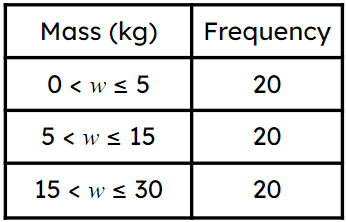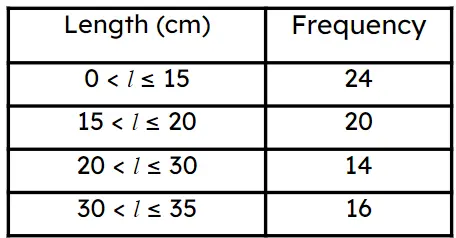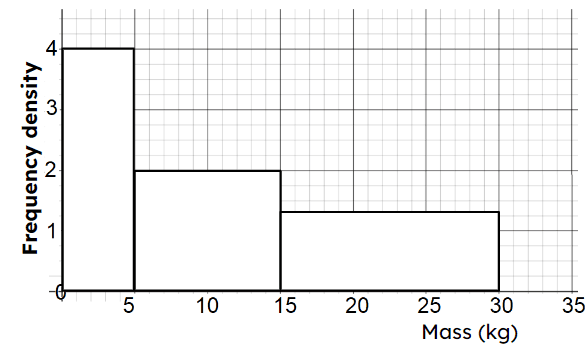Myths about teaching can hold you back


- Year 11•
- Higher


- Year 11•
- Higher
Histograms with unequal bar width
I can construct a histogram from a table.
These resources were made for remote use during the pandemic, not classroom teaching.
Switch to our new teaching resources now - designed by teachers and leading subject experts, and tested in classrooms.
Lesson details
Key learning points
- Sometimes data is presented using unequal class widths
- In order to compare, frequency density is used
- Frequency density is proportional to the frequency per unit for the data in each class
- Frequency is proportional to the area of the bar
Keywords
Frequency density - Frequency density is proportional to the frequency per unit for the data in each class. Often, the multiplier is 1 meaning that frequency density = frequency ÷ class width.
Common misconception
Histograms with unequal bar widths are plotted against the frequency and/or pupils read the frequency density as the frequency of the class width.
Show what a histogram with unequal bar widths looks like when plotted against frequency. This visual aid will show pupils the distribution of data is difficult to see.
To help you plan your year 11 maths lesson on: Histograms with unequal bar width, download all teaching resources for free and adapt to suit your pupils' needs...
To help you plan your year 11 maths lesson on: Histograms with unequal bar width, download all teaching resources for free and adapt to suit your pupils' needs.
The starter quiz will activate and check your pupils' prior knowledge, with versions available both with and without answers in PDF format.
We use learning cycles to break down learning into key concepts or ideas linked to the learning outcome. Each learning cycle features explanations with checks for understanding and practice tasks with feedback. All of this is found in our slide decks, ready for you to download and edit. The practice tasks are also available as printable worksheets and some lessons have additional materials with extra material you might need for teaching the lesson.
The assessment exit quiz will test your pupils' understanding of the key learning points.
Our video is a tool for planning, showing how other teachers might teach the lesson, offering helpful tips, modelled explanations and inspiration for your own delivery in the classroom. Plus, you can set it as homework or revision for pupils and keep their learning on track by sharing an online pupil version of this lesson.
Explore more key stage 4 maths lessons from the Graphical representations of data: cumulative frequency and histograms unit, dive into the full secondary maths curriculum, or learn more about lesson planning.

Licence
Prior knowledge starter quiz
6 Questions
Q1.Select the examples of discrete data.
Q2.When constructing a histogram with equal bar widths, select which of the following are important points to remember.
Q3.Here is a table showing the time people spent doing physical activity during a day. How many people spent more than 2 hours doing physical activity?

Q4.Here is a histogram showing times taken to complete an IQ test. What percentage of people took more than 10 minutes to complete the IQ test?

Q5.Here is a histogram showing how long people played a game for before they lost their first life. What percentage of people played for 20 seconds or more?

Q6.Here is a histogram showing how long people played a game for before they lost their first life. What percentage of people played for 40 seconds or more?

Assessment exit quiz
6 Questions
Q1.Match the type of density with the definition.
Frequency density -
is proportional to the frequency per unit for the data in each class.
Population density -
is the number of people living per unit of area.
Substance density -
is measured as the substance's mass per unit of volume.
Q2.Which of the following explains why we plot continuous data with unequal bar widths against frequency density?
Q3.Match the frequency density with the correct class interval.

$$0 < w \leq 5$$ -
Frequency density = 4
$$5 < w \leq 15$$ -
Frequency density = 2
$$15 < w \leq 30$$ -
Frequency density = $$\frac{4}{3}$$
Q4.Match the frequency density with the correct class interval.

$$0 < l \leq 15$$ -
Frequency density = 1.6
$$15 < l \leq 20$$ -
Frequency density = 4
$$20 < l \leq 30$$ -
Frequency density = 1.4
$$30 < l \leq 35$$ -
Frequency density = 3.2
Q5.Here is a histogram showing the masses of different parcels. Which class interval shows for every 1 kg, there are 2 parcels?


